The Submission
THE MOST FUN I HAVE PLAYING MAGIC
1. History
In barbarian times competitive Magic was dominated by more Tutors than an East-Coast city a week before the SAT, and creatures were as uncompetitive as a poor applicant to Harvard. Then the power of Tutors, which (as anyone who has spent time at rich-kid circle-jerks, like EDH games or Ivy-League colleges) in excess homogenize and impoverish experience, began to wane; thus the snap-bannable Demonic Consultation turned into the bannable Mystical Tutor, which turned into the totally unbannable Survival of the Fittest; by the time Eladamri’s Call hit stores, social Darwinism was fighting, toe-to-toe, with Mirage-era scholasticism.
Now it is 2013 and Darwinism has won. Gone is the fire-and-brimstone medievalism of Demonic Tutor. In this place we have cards like Idyllic Tutor, for which the competitive player reserves his most damning of epithets: EDH staple.
But if Demonic Tutor is a bad design choice, and Idyllic Tutor is just a bad card, where does this leave the Tutor-inclined Cube designer? Assume that the author likes creatures and durdling. Justify your answer in 3,500 words or less.
2. Biology
The one unambiguous design success of New World Order has been to make creatures competitive; I’d also argue that NWO has made creatures competitive in a more interesting way than ever before. The primitive tribal designs of Onslaught and its inferior successor Lorwyn are fading into memory, compelling Cube and set designer alike to make more interesting, less linear design choices than ‘lol let’s put in some Faeries!!!’ Now you can build creature decks around curve and synergy and lifegain, and a score of other cross-pollinating criteria; you can build Birthing Pod decks and Veteran Explorer decks and decks with Shardless Agent and Bloodbraid Elf. Now Llanowar Elves and Wild Nacatl are both having their day; now Gaddock Teeg and Tarmogoyf stand, side-by-side, as bros (if not equals).
Green is now not only competitive, it is skill-testing. It might even be cerebral. Green is too hard to play for masters, and too easy for morons. Green is Greenwich Village in 2000, the Pearl District in 2007, and Eastern Europe for the rest of the century. Green isn’t the new Blue — Blue is the old Green.
At my Cube, half the players are high on Green — some are so high, they even first-pick the Greens! Magic is attracting greenhorns at greenback-garnering rates when they visit the local greengrocer; there are now more Green mages playing Magic than there are members of the Green party. Green is making the White players whitewashed, the Red players see red, and the Blue and Black players Black and Blue in mood and bruise. Green is making everyone from the green thumbs to the Green Berets Green. How?
In Modern, Green is the best color because all the good cards are banned of Birthing Pod. Birthing Pod is a card I am far too dumb to play when sober, and too smart to play when I am drunk. I am indebted to Jason for pioneering Birthing Pod designs in Cube; I have been happy to throw three in my Cube. But I love Green far more than Jason, and I want to double up on two cards I love more than Birthing Pod.
The first of these cards is, along with Stoneforge Mystic, one of the strongest tutors printed since Tinker. It perfectly uses the intrinsic brokenness of tutors to buff Green dudes, and it uses the fairness of Green dudes to ‘unbreak’ tutors. In Cube, as in Constructed, it leads to dizzying arrays of deckbuilding and gameplay decisions. Glory be to Green! Through this card, both the coolest of the old tutors and the NWO triumph of creatures, realize their design potential — as instigators of tough decisions and ‘every game being different,’ not the opposite.
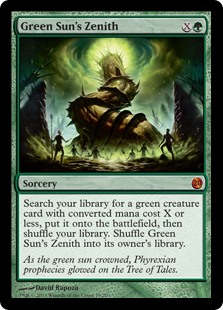
3. Meteorology
As a tutor, GSZ is broken; as a tutor that puts onto the battlefield, it is twice broken. However, as a tutor that gets only creatures, it is fair; as a tutor that gets only green creatures, it is twice fair.
In Legacy, GSZ is known for creating a handful of archetypes (Maverick, Nic Fit) while revitalizing others (Elves, the rage-inducing Enchantress). There its raw power is brought fully out by the massive card pool. GSZ is, like King Azaz the Unabridged, the Alpha and the Omega; from Aboroth to Zuo Ci, the Mocking Sage, you can grab anything under the Sun — the Green Sun. But there are more Green creatures in Magic history than in my Cube. Just as large card pools break tutors, a careful Cube design can ‘unbreak’ them. In my Cube specifically, there are a hair under 70 targets; this is few enough that there will not be Craterhoofs for 40 on turn three, but enough that you can do all this fun stuff!:
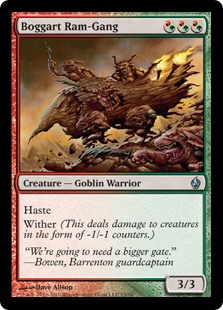
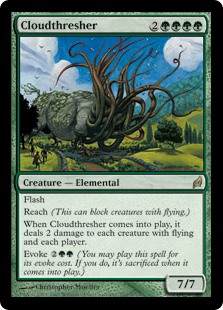
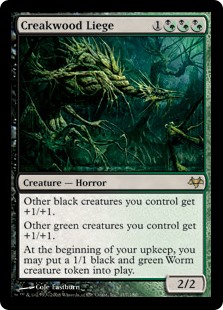
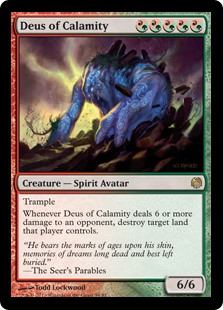
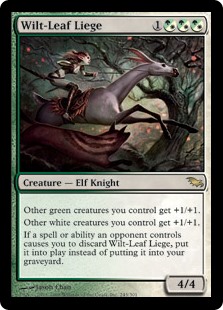
For the cost of a single Green mana, GSZ fetches color-intensive cards. GSZ synergizes with the new Devotion themes of Purphoros, God of the Forge, Erebos, God of the Dead, and Nylea, God of the Hunt. GSZ mitigates the issue of color screw, that has ruined innumerably more games of Cube than that straw man in the corner drafting ‘five-color good stuff.’
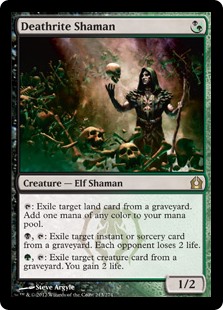
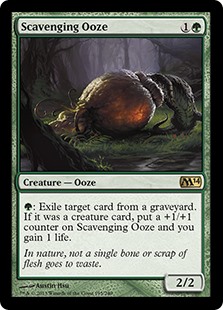
I dislike Power Cube for many reasons, but the main one is that its threats far stronger than its answers; are you gonna crack that Lotus to power out a t1 Jace, the Mind Sculptor, or are you gonna use that triple-Blue to hold up Cryptic Command? In Power Cube, the games are too often EDH-style slugfests, with a minimum of interaction, therefore psychology, therefore the things that make MTG so much fun.
The bias towards questions over answers is, I think, connected to a limitation of singleton formats: with singleton, you can’t help but underrepresent certain types of cards, and those cards are usually answers. In my Cube, with both a powerful Reanimator and Gravecrawler theme, I knew that I wanted a critical mass of answers to the graveyard. However, I felt ridiculous adding cards, like Withered Wretch or Loaming Shaman, that were not main-deckable; that kind of card would always fall to 14th pick, would always be boarded in when it hosed, and would otherwise not see the light of day. This is a bad dynamic for drafting, sideboarding, and playing — nearly as lazy as throwing Vulshok Refugee in the Great Furnace Modo Cube!
So instead of digging deep in fallow earth, I doubled up on Deathrites and Scoozes, either of which you can grab with a Zenith. (The mana production of Deathrite Shaman also powers out on-curve GSZs.)
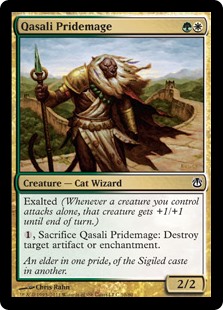
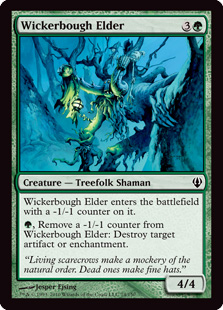
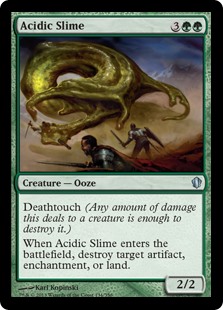
I wanted an extra piece of main-deckable artifact-and-enchantment removal, too, but I didn’t want to add a second Wickerbough Elder (for aesthetics and curve), nor a first Viridian Zealot (for lack of power).
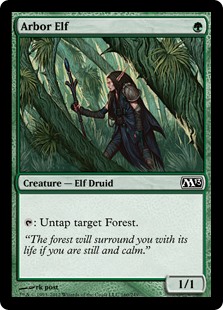
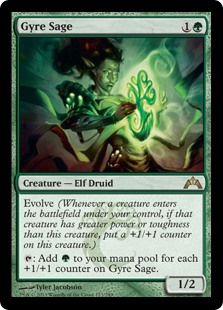
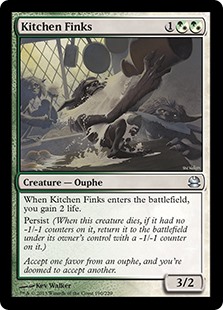
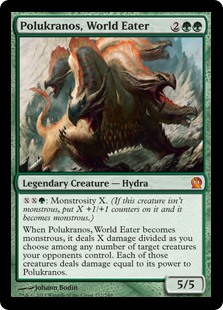
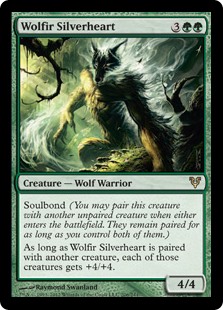
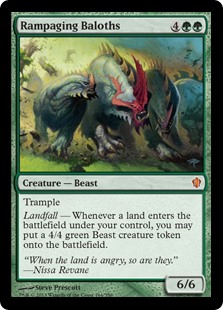
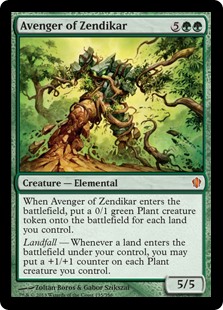
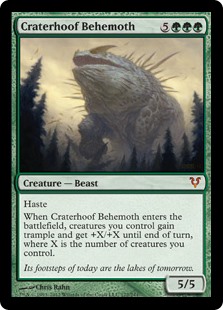
At any point on the curve, GSZ is your best card — you just have to draft the GSZs, draft the creatures, and remember what’s in your deck.
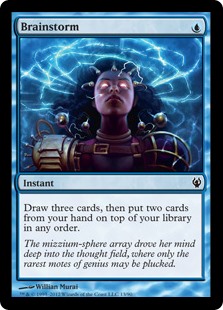
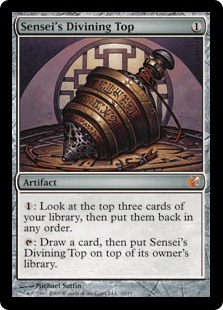

Legacy aficionados will love the little complexity of GSZ’s shuffle effect. The doubled-up fetches do double duty with GSZ to really give the three Brainstorms a big boost, while turning Deathrite Shaman into a reliable mana dork.
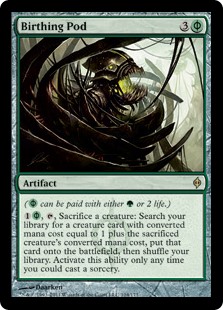
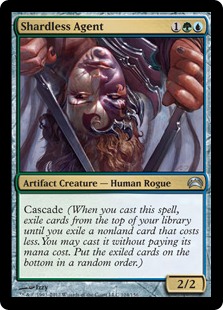
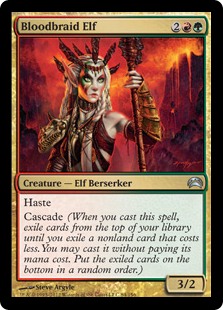
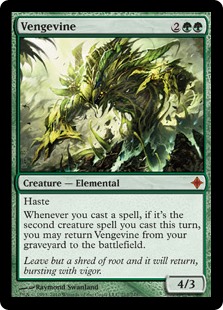
As in Legacy, GSZ can’t work well with everything — otherwise, it’d go in everything. As is, the anti-synergies between GSZ and Pod and Cascade help situate GSZ in a nice spot in between that ‘going in everything’ (dat Batterskull) and ‘going only in one deck’. The way GSZ, Pod, and Cascade act as competing engines also adds extra diversity to decks and archetypes. Which kind of Green deck do you want to build?
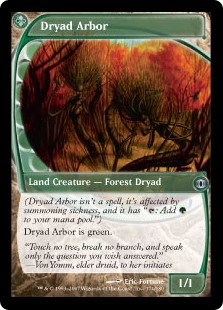
Mana dorks are another card underrepresented in Cube, but here the utility land draft both alleviates this lack of t1 acceleration, and grants an enormous boon to GSZ. When GSZ was in Standard, the extra mana made it at times clumsy, but in Legacy you can just cast GSZ for X=0, find your Dryad Arbor, and have that extra mana to cast your second GSZ.
But wait! There’s more. My utility land section (drafted with two lands per person, twice in each draft) inspired me to double up on my double trouble. I am a double agent writing a double feature on double lives. I do not dislike double negatives. I I have been known to order double drinks at the bar, then double up in a double bed. My favorite item at In-N-Out is the Double-Double.
Double, double, Toil // Trouble;
Fire burn, and cauldron bubble;
Disclose a babe of Brawn and hooters,
Who beats and taps and sacs and tutors …
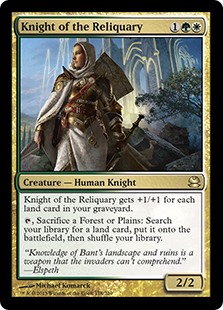
Maverick, the original Legacy GSZ deck, played four of this strong, beautiful woman. Brian Kibler, himself a looker, called her (and I paraphrase) ‘the sweetest card in Magic,’ and surely it is. Why does KotR arouse the passions of old-school Magic players, to an even greater degree than ‘anything that moves’?
Just as NWO’s signature design success is balancing the creature and the spell, its signature design failure is its wholesale slaughter of on-board complexity. Anyone who has played a game of Standard the last couple of years knows what I mean. NWO games are too often boring. I know why. The whole point of Cube is for good players to screw up — Cube is like EDH, for thinking players — and what gives them a bigger chance to screw up than activated abilities? Activated abilities that tutor, of course! (And, after picking up The Name of the Rose this weekend, I wonder if ‘Reliquary’ is a reference to medieval attitudes on tutoring …)
So what does Kibler’s girl have to teach us?
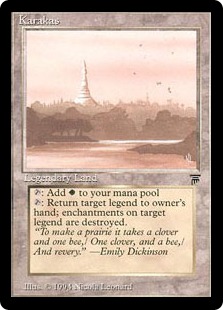
If the new, completely terrible legend rule won’t let clones light up legends, the classic Legends legendary land will light up legends.
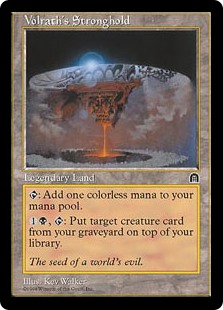
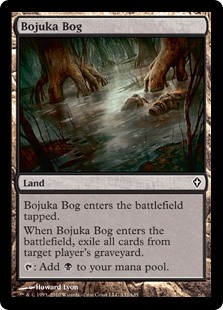
Lovers of older formats will also enjoy recurring dudes, and nuking their opponents’ graveyards when they try to do the same. This ‘dynamic equilibrium’ finds the right balance between questions and answers. (I try to build my Cube with the design successes of Legacy in mind; the tension between Wasteland + Stifle and fetch + dual, or Force of Will and broken strategies, is the biggest reason why that format works.) In my Cube, KotR teams up with GSZ, DRS, and Scooze to create a fun, fighting dynamic between Green and graveyard strategies.
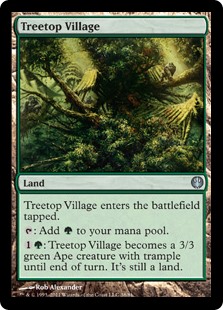

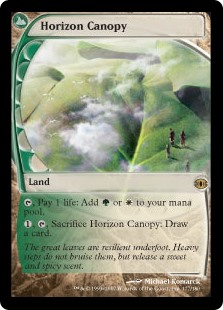
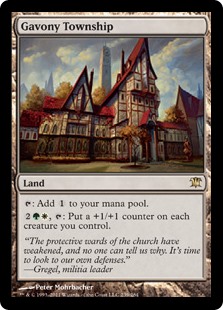
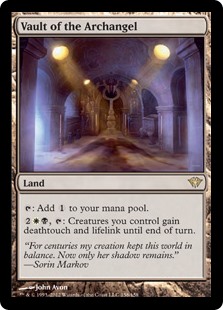
KotR can also make bodies, draw cards, pump our team, or give an alpha-striking aggro deck a very ghastly surprise.
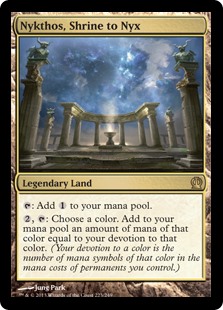
In my fixing-saturated Cube, Nykthos provides an incentive for decks to stick to a primary color, tapping for huge amounts of mana once you’ve fetched that Deus of Calamity with GSZ.
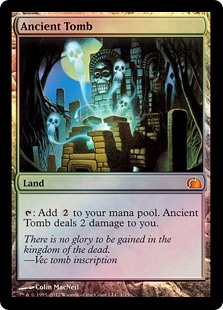
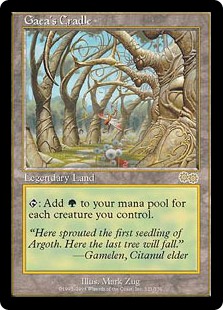
KotR’s ability to ramp (sacrificing a turn of blocking by not activating at the end of the opponent’s turn) is buffed by these powerful cards with drawbacks …


… While her body is buffed to Cube-worthy proportions by the twenty fetchlands in my 450-card list …
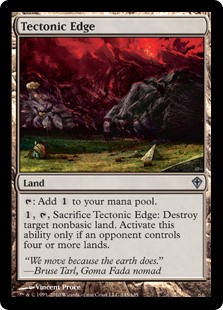

… And these balanced answers to the ancient lands her archaeology unearths.


Between GSZ and KotR activations, the shuffles, tutors, and cantrips in my Cube maximize decision points in drafting, deckbuilding, and gameplay, lifting it above the vulgarity of ‘RDW in the Modo Cube,’ and synthesizing cards old and new — the tutor and the creature — for a flavorful, interactive, and challenging experience.
Add growlers, daggers, and Legacy side games to taste!
5. Rhetoric
Travis Woo is fond of saying ‘to add a card you must cut a card.’ Peddlers of MTGS-style Powered 720s miss that this is as true in Cube as it is in Constructed. All design choices come with opportunity costs, so here are some arguments for not doubling up on GSZ and KotR, (as well as my doubling-down, double-negative arguments against those arguments):
-Green is already the easiest color to design in Cube. Though my idolatry of Green is profuse and well-documented, even the most hardened Blue-worshipping philistines can’t help but marvel at Green’s embarrassment of riches in Cube. Between its mana dorks, on-curve beaters, fixing and fatties, there are about 30 Green cards I want in my Cube that aren’t in there; so why spend two precious slots on a second GSZ and KotR? I’d answer that these cards make the existing cards in the Cube more playable in more situations, so by doubling up on them, on balance, my drafters see a greater diversity of cards.
–Selesnya too is not lacking in options. I share Jason’s contempt for precise color-balance; I see it as maybe the fifteenth-most important thing you can do with your Cube, while more pedantic ‘designers’ fetishize it as a means of ignoring fundamentally rotten design. GW has way more Cube-worthy cards than UR or UG, so there are more GW cards than UR or UG cards in my Cube. (As compensation, U gets more mono-colored cards.) However, there are some more GW cards I’d like to slot in. Though a second KotR is unquestionably cooler than a first Loxodon Smiter, some designers might not judge it sweeter than a Glare of Subdual or, at the same spot in the curve, a Dauntless Escort. But I do!
–Midrange is already strong enough. There is a ‘five-color good-stuff’ fallacy. It is popular among the rote Cube community. It states that Cubes with a sad sparseness of fixing are somehow supposed to make oppressively powerful ‘five-color midrange’ decks. This is dumb for several reasons. A big one is that anyone who’s played Constructed will remember how bad directionless midrange decks were, even in the mono-dual mana-bases of RTR Standard. It is true, though, that midrange decks do tend to be strong in non-power Cubes. This is especially true for riptidelab.com Cubes, where we de-emphasize sweepers and love Green, maybe taking both a little too far. I’d answer that the competing Green ‘engines’ of Birthing Pod and Cascade are more restrictively midrange, while GSZ fits in aggro and ramp too — and that Knight is just ‘the sweetest card inMagic,’ anytime, anywhere.
-Everything costs 3. This is related to the last argument, and is especially true for gold cards; 88 out of 381 = 23.1% of my Cube’s spells have CMC 3, while 25 of 75 = 33.3% of its gold cards cost 3. Anyone who has looked at Matthew Watkins’s excellent articles on new Limited formats, or the article of Andy’s I linked above, knows how extremely sensitive Limited environments are to slight changes in curve. Three is a CMC Cube designers should actively be looking to quell, though it is nowhere near as bad as having everything cost 4. (Aside: I’m sure that conventional Cubes’ having curves that very closely approximate released draft sets, while having the power of Constructed cards, is a design failure that explains a great deal of my disregard for them.) Anyway, I’d answer that GSZ can cost anything from 1 to 9 mana, and the two KotR slots are worth it in spite of both costing 3.
–Green Sun’s Zenith is not as customizable in 40-card decks. At some point in my Cube games, with my Cube’s twenty fetchlands and four utility lands per person, someone will fail to find off a fetch and it will feel awful. Similarly, with GSZ in a forty-card deck, you can just run out of bullets; maybe that extra GSZ should therefore be another bullet. I’d answer that the fetches and Birthing Pod design choices are worth it anyway; finding something cheaper than the value of X off GSZ isn’t so bad. Plus, curbing GSZ’s power a little is something I’m down with; I love GSZ, but the card is banned in Modern for a reason. (I have, however, thought about mandating 45-card decks …)
–Dryad Arbor sucks without GSZ. This is a ‘poison-principle’ argument — anyone who’s topdecked a copy during a tight game of Legacy knows that Dryad Arbor is a weak card, whose application is overwhelmingly accelerating off a GSZ on turn one. I’d answer that I’ve strived to give it a few other uses — e.g., KotR’s ability to tutor it, finding a surprise blocker off a fetchland, and serving as fodder for the sacrifice theme — and also that Dryad Arbor isn’t in the main Cube. The utility-land draft is for cards you want to put in your deck, that aren’t worth the opportunity cost of a designer’s slot and a drafter’s pick; that’s the whole point!
6. Game Theory
The great deckbuilders give huge amounts of attention to individual card choices; for this reason, I value the perspicacious Legacy articles of Josh Ravitz, whose descriptions of brewing approximate my experiences at April’s Seattle Legacy Open. There I could have lost in the quarterfinals because of a single poor card choice in the sideboard. Why, then, do Cube designers, especially the ones who are accomplished competitive players, not obsess over their Cube’s card choices? You could answer ‘because in competitive Magic there’s money at stake,’ but nobody plays Magic for money — a professional Magic player is simply someone who is unaware of this. We’re all doing this for fun; fun is the most important thing.
To this end, I am now going to tell a story that will illustrate why I think Cube is more important than competitive Magic.
A couple months ago, our playgroup’s most dedicated player went off to Dublin for the Pro Tour. After bumming around Europe for a month, he returned, determined to never play a round of competitive Magic again: ‘I don’t want to be anything like these people,’ he explained. That Thursday he came over for Cube and, by the time he’d blithely Podded Erebos, God of the Dead into a Gray Merchant of Asphodel for 17, he was in great spirits. ‘This is the most fun I have playing Magic,’ he commented, in a rare display of sozzled sentimentality … That Saturday, he came to the PTQ, and, though we all scrubbed out, we realized it was no excuse for not enjoying the mojitos and Cubing thereafter, as we love Magic not because of the way competitive play is set up, but in spite of it.
Some weekends I will not feel like going to PTQs; some weekends I will go to PTQs and not enjoy myself; on balance, I get some fun out of it, but I keep going because I love my Magic friends, more than I hate the early reveilles and bush-league backbiting and atrociously high vigorish of the PTQ and GP circuit. But I’ll always try to get Cube together, every week, as there is no way I am not going to have a huge amount of fun designing or drafting or playing my Cube; it is so fun that the pointless suffering of the outside culture and the very bad Limited sets this culture has fed become, for several hours, immaterial. What the daggers and drinking and gossip outside the game, and the interaction and decision trees and dialectics and tensions and hand-reading and tutoring and designing, drafting, deckbuilding, and playing within the game ought to remind you of is that, at its best, MTG is a game about people. For all my criticism of WotC, I am glad they’ve been able to accommodate idiots who like giant Green dudes, like me, alongside the tutor-mongering legacies of yore.
Jason’s Critique
There’s a lot to unpack here. I’ll start by saying that, currently in my cube, Green Sun’s Zenith does not seem to be valued very highly by my drafters. Mistake? Perhaps. I have long touted the idea that Primeval Titan engine decks are the most fun green decks my cube produces, via a combination of the Utility Land Draft and the fact that you get to pilot a deck with a legitimate, cool, non-broken interactive gameplan rather than drawing off the top. For this reason I’ve heralded cards like Primal Command as ways to enable such decks.
Green Sun’s Zenith does similar enabling. And if we’re doubling up on the Zenith, do we double up on Dryad Arbor in the utility pile? Zenith significantly improves with a zero-drop to fetch, and, should the two copies get split, do we want one of the two to be a bit of a dud? It’s certainly a question worth considering. I hadn’t considered the connection to blue with Brainstorm, and as someone currently in the process of upping my Brainstorm count this does seem appealing.
Further, I consider giving decks a good decision density an integral part of cube design, and as an X spell, Zenith certainly has no shortage of play to it.
A second copy of Knight of the Reliquary could be useful, but I do feel that limiting gold density in cubes is important design wise, by virtue of the higher competing demand for monocolor cards. You’re right, to add a card I need to cut a card. What’s my line?

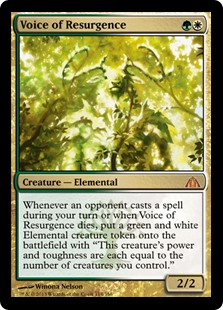
Both of the above cards are fairly integral to my cube’s design (Voice single-handedly makes Pod decks more viable), and Qasali is a rare maindeckable piece of artifact and enchantment hate. I’m not entirely against adding a fourth Selesnya card, but I don’t know that I’m sold on a second copy of Knight of the Reliquary. Certainly anybody doubling fetches and using the Utility Land Draft should be running at least one copy, though.
Eric’s Critique
Anybody wanna take a guess at who wrote this submission? Yeah, no, I’m pretty stumped here, too. It could have been just about anyone.
So, right off the bat, suggesting that people include more than a singleton copy of Green Sun’s Zenith sets off alarm bells. It’s probably more of a personal bias than anything else, but I feel like cards that vastly increase the consistency of decks – tutors especially – make cube less interesting. It’s one thing to need to draft a very specific curve in order to fully unlock the potential of Birthing Pod; it’s another to just draft Good Green Creatures and know that you’ll be able to treat your library as an extension of your hand. I think that Zenith is actually a decent bit closer to Demonic Tutor than, say, a Worldly Tutor, and Demonic Tutor trips the smoke detector in the same way. Maybe this is all moot if Dryad Arbor isn’t in your particular deck packing multiple Zeniths, but I’d still be very wary of including more than one copy of a generically powerful, flexible spell such as this (especially when it reshuffles itself back into the library to act as marginally more copies).
After having pooh-poohed all over that idea, I will say that I’m fascinated by the idea of a second Knight of the Reliquary. This beloved three-drop brings an often under-appreciated part of the deck – its manabase – right to the forefront, and allows for any manner of subtle and not-so-subtle shenanigans, while still inviting interaction from the opponent. With just one copy in a deck, it’s hard to really build around her ability, and expect to be able to harness the full power of your utility lands. A second copy would give a drafter more motivation to stock up on fetchlands, play sufficient numbers of Forests and Plains, craft a game plan around activating Gavony Township in a creature mirror, and run any number of silver bullet lands to handle any imaginable scenario. Other than amassing an army of dudes, I find that GW decks often lack direction in cube. Knight of the Reliquary is perhaps just the gal to bring the colour pair together.
It’s true that gold sections are very tight in cubes as is, and Selesnya as a color pair isn’t lacking for options. I think that Knight is unique enough to warrant taking a good, hard look at doing everything you can to squeeze in another copy. Move over, Baneslayer – the Queen of Midrange has arrived.
Return to contest entries.

